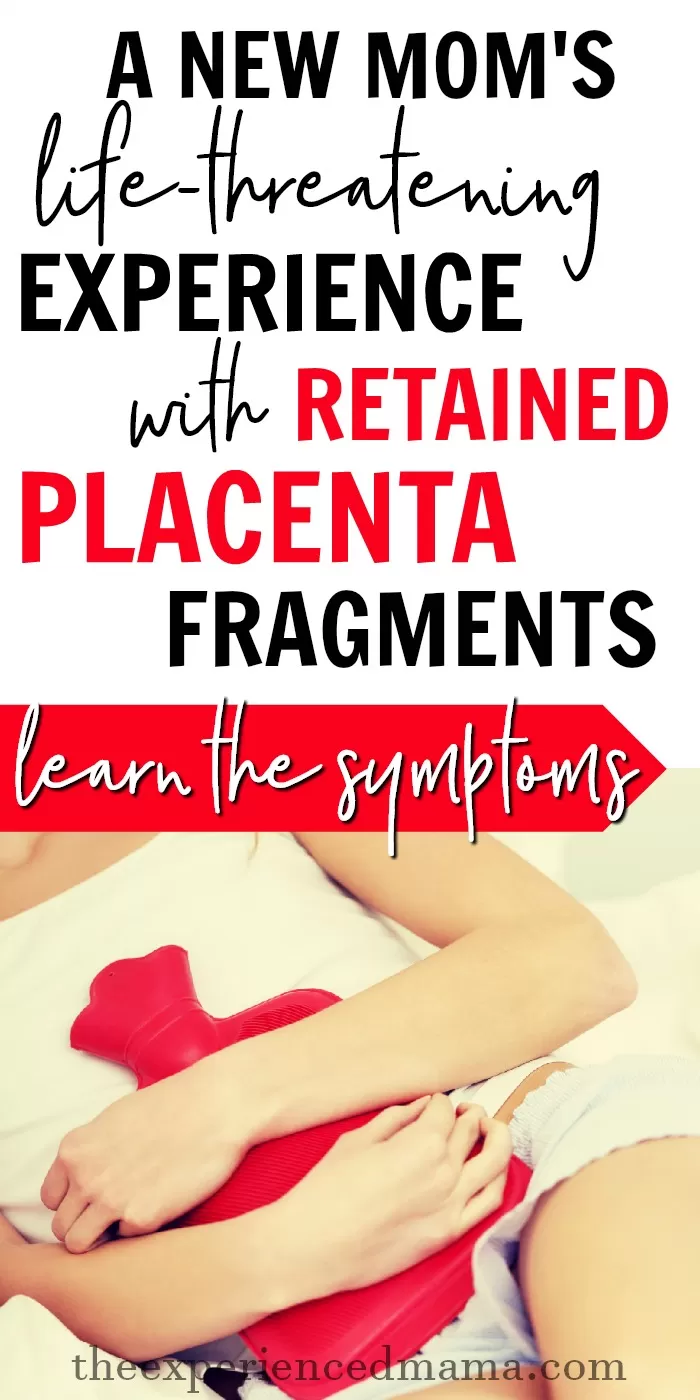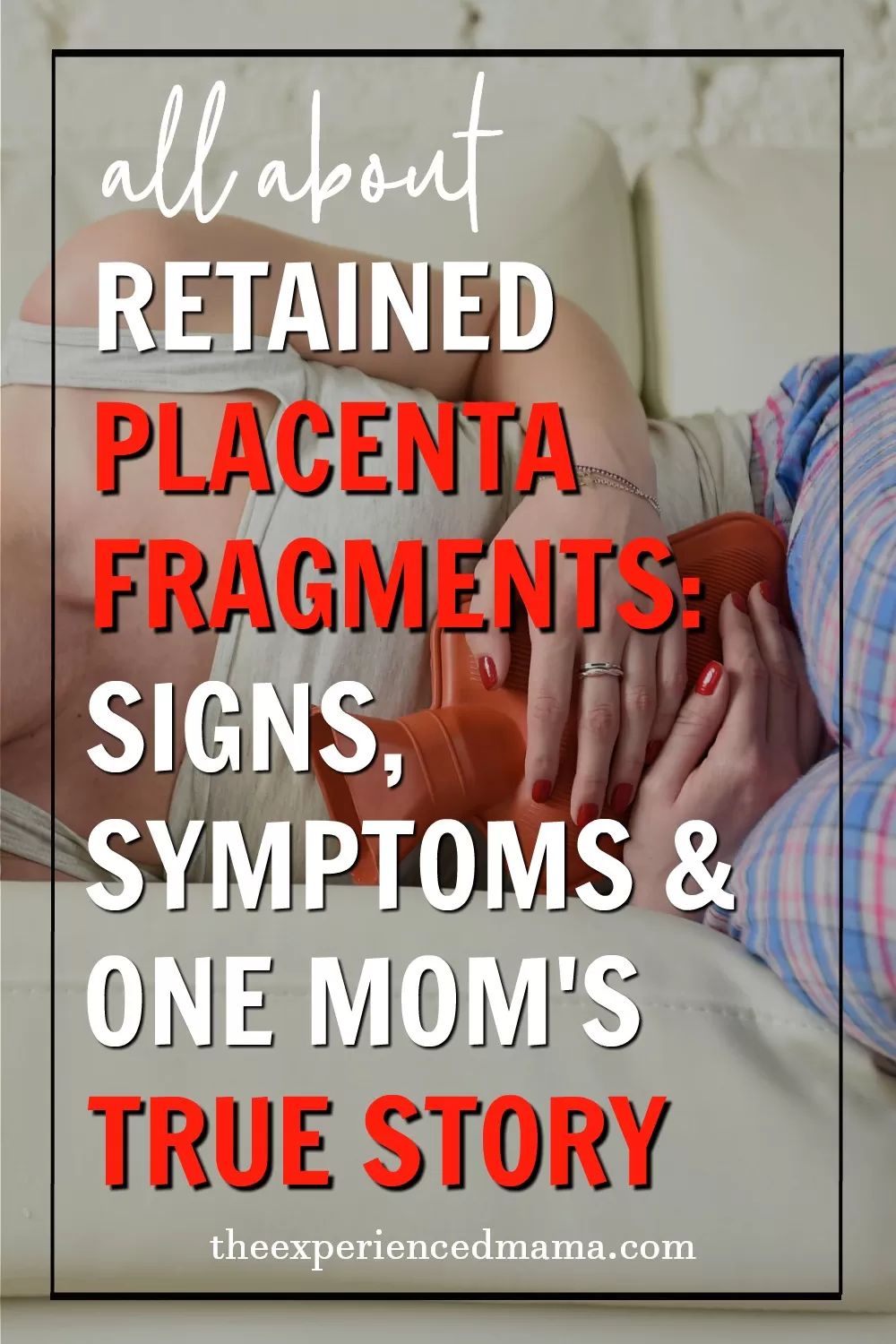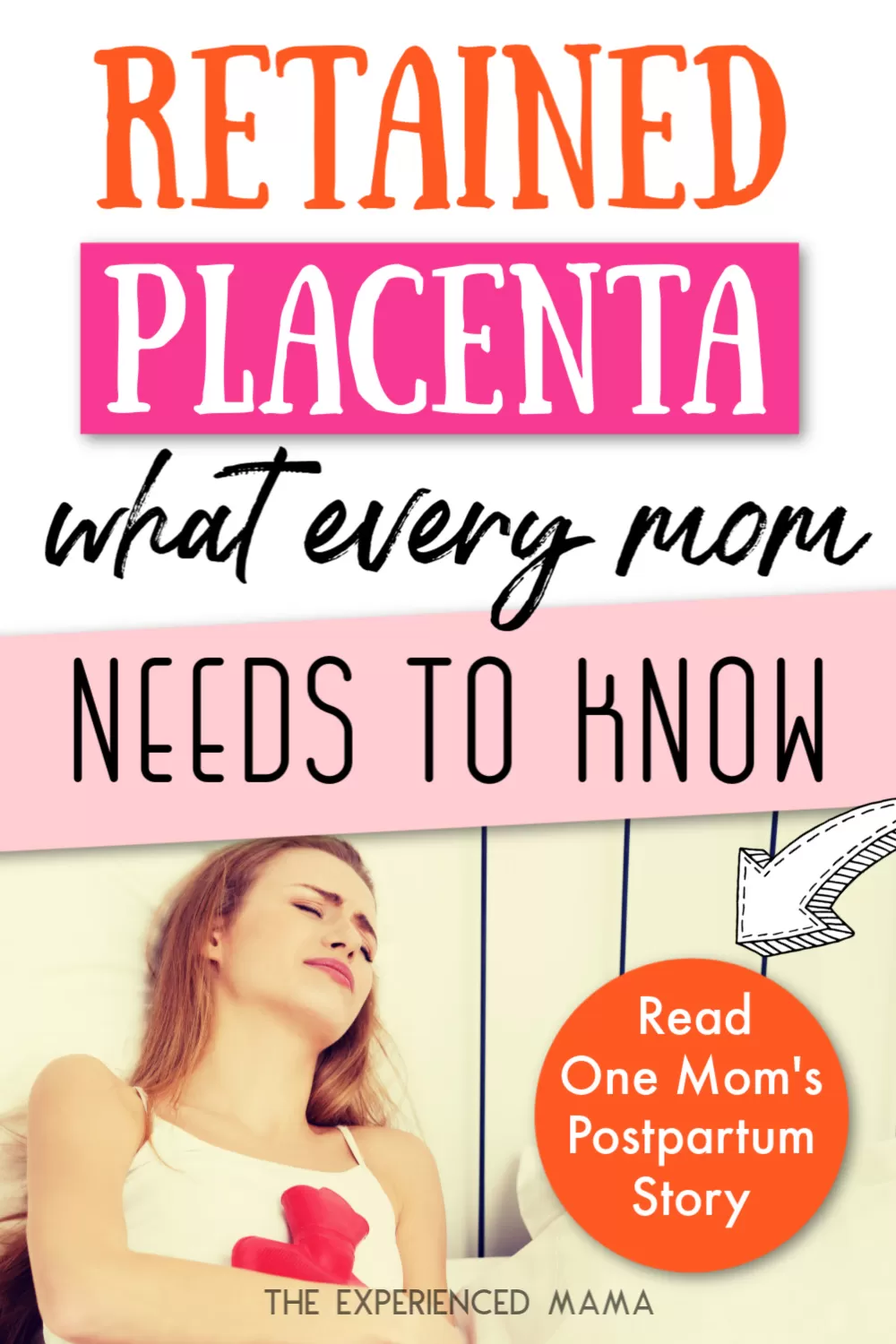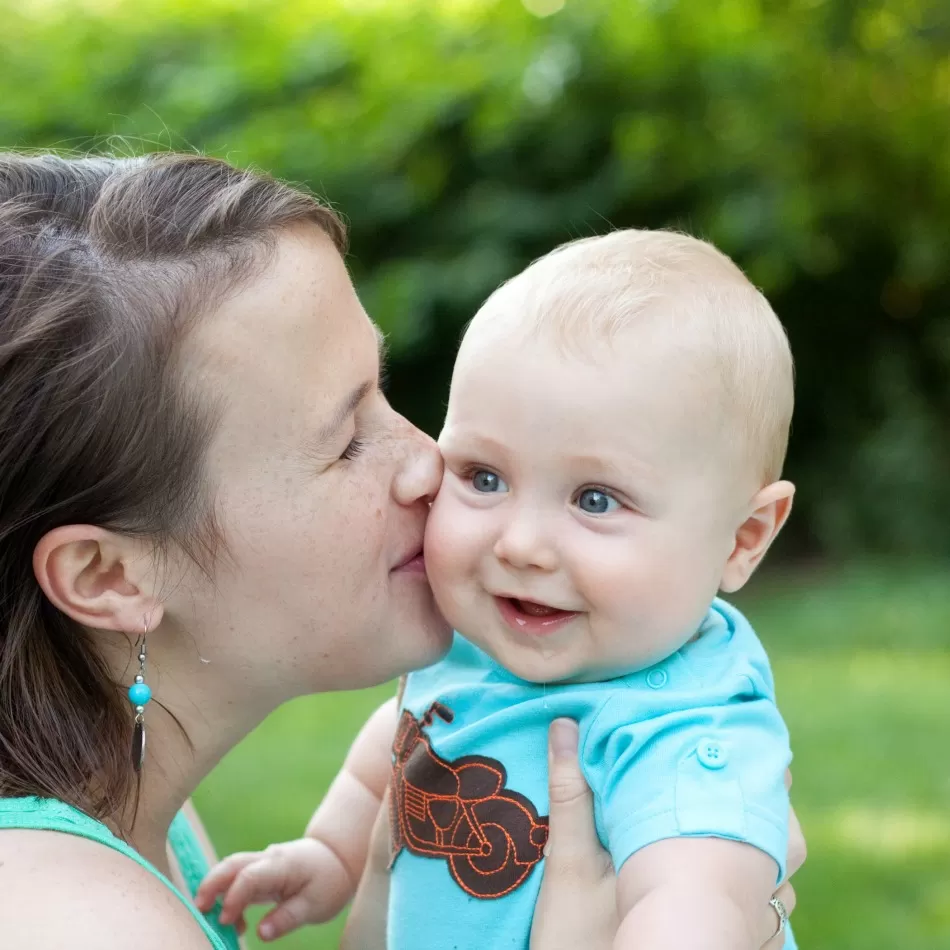Inside: Retained placenta fragments are an uncommon postpartum complication, but it does happen. One mom’s story can help you recognize the signs and symptoms from the start, so you can get help as soon as possible.
During all your pregnancy preparations, you don’t often hear about the things that can go wrong after labor and delivery. Certain complication are rare, but the more birth and postpartum stories I hear from moms who experienced a variety of uncommon complications, the more convinced I am that ignorance is NOT bliss.
Knowledge can save lives, especially for first-time moms who don’t yet know the normal limits for postpartum aches and pains.
I am not a physician, and the information shared in this article are not intended in any way intended to diagnose or treat retained placenta, but to share one mom’s experience having retained placenta fragments. If you are experiencing any of the symptoms shared here, consult your personal physician for advice and diagnosis.

What Are Retained Placenta Fragments?
THIS POST PROBABLY CONTAINS AFFILIATE LINKS. AS AN AMAZON ASSOCIATE, I EARN FROM QUALIFYING PURCHASES. YOU CAN READ OUR FULL DISCLOSURE POLICY HERE.
After delivering the baby, most moms consider labor and delivery complete. But labor isn’t actually finished until the placenta is delivered.
Typically, the placenta needs to be delivered within 30-60 minutes after the baby comes out. Once the placenta is delivered, oxytocin is typically given in order to reduce the amount of bleeding from the uterus.
If the placenta is not delivered within the 30 – 60 minutes, the mom is considered to have retained placenta. Retained placenta can be treated in a variety of ways (source):
- Manual removal by the doctor (not ideal as it increases risk of infection)
- Medications that encourage the placenta to separate and deliver
- Breastfeeding to cause the uterus to contract to deliver the placenta
Retained placenta fragments develop when the placenta appears to have fully delivered, but in reality, small and often undetectable parts of the placenta remain in the uterus.
If any part of the placenta remains in the uterus, the mother is at risk of infection or even death. Early detection is essential.
I hope that Sonia’s story can raise awareness among new moms, so that they know the signs and symptoms of retained placenta fragments in order to get treatment as early as possible.
The symptoms of retained placental fragments can be found after Sonia’s story.
(One way to be more confident going into labor and delivery is to take a childbirth class. But who has time for that? Plus, learning about childbirth with total strangers…awkward. This online course is such a great option, created by a labor & delivery nurse, so you can get everything you need to know, but on your couch in your PJs.)
Related: I Had Urinary Retention After Birth – Here’s How I Coped

Retained Placenta Fragments: One Mom’s Experience
Thank you to my friend Sonia for being willing to recount what was certainly a traumatic experience, so that new moms can be aware of the signs and symptoms of postpartum fragments. This is her story in her own words.
It was a surprise when I became pregnant with my first baby. The timing didn’t match up with our plans, but as soon as we knew, we were so excited. I had minimal morning sickness and a fairly smooth pregnancy.
At 18 weeks we found out we were going to have a boy and we immediately knew what we would name him. At 26 weeks while we went on a road trip-babymoon our sweet baby gave me a good strong kick and broke my rib. Since I kept growing as my baby grew, the bones couldn’t heal and gave me some pain throughout my pregnancy.
Aside from that, the pregnancy progressed smoothly with our little guy developing well. Throughout pregnancy I received prenatal care alternating between a midwife and a doctor who worked together on a team with other doctors and midwives.
Seemingly Normal Labor and Delivery
At just around 40 weeks, while I was having semi-consistent contractions, my husband and I took a long walk and then I heard a pop of my water breaking. We called the hospital and they told us to come in.
I labored all night and was not progressing. I realized now that despite taking birthing classes, I had no idea what I was doing because I had never done this before. My response to the pain of contractions was to tighten up. You know how they say to relax through a contraction? I had no idea how to actually do that. But they know what they’re talking about! Shocking! It worked in my two subsequent labors, but I just couldn’t figure it all out.
After laboring all night, not progressing, being exhausted and mentally done, I had an epidural and they started me on pitocin, and I slept for a few hours. My favorite memory was falling asleep to the sound of my baby’s heartbeat on the monitor knowing that he had fallen asleep to the sound of mine all pregnancy long. When I woke up, I had finally progressed and it was time to push.
I pushed for 45 minutes and gave birth to this beautiful baby boy with a head full of dark hair. When I delivered the placenta the team of nurses and the midwife seemed to think everything looked good and they had someone come stitch me up as I had torn.
I went home two days later exhausted, a tad bewildered, and completely in love.
Signs of Retained Placenta Fragments Starting to Develop
When I got home, I experienced a lot of pain, but just thought to myself that recovering from labor was harder than I thought it would be because I had never done this before and had no idea what to expect.
I was raised in a “suck it up” family and kept pushing right through the discomfort I was experiencing.
Two days after that, my sweet boy was supposed to go for his first doctor appointment. At that point we had been keeping him in a bassinet on the floor of his room. I went in to his room that morning, knelt down to pick him up, and couldn’t get back up. I called for my husband, and we decided to call the doctor.
When we called my doctor/ midwife team they said that they had an office wide meeting and couldn’t take any appointments. So, we called my primary care physician to see if I could go see her while my son went to his appointment in the same building.
By the time we got there I couldn’t really walk, but I made my way up to the office. When my doctor saw me she said, “I don’t know what’s wrong, but this is not normal.”
Since I had never done this before, I had no idea what normal felt like and was half thankful to at least know that this was not it. That doctor told us to go to the emergency room at a different hospital (Boston has a lot of hospitals). When we came out to our car, we had a ticket for an expired inspection.
Perfect.
We headed over to the other hospital and went in the emergency room. Everyone had masks on because one of the major flu outbreaks was going around at the time.
My amazing sister came and picked up my sweet newborn baby, so he didn’t have to be in a den of sickness. While we were in the waiting room, I didn’t feel like we should be there. It didn’t make sense to me to go to a different hospital and not be seen by the ones who had treated me up until that point
My husband called the doctor/ midwife office again, and they said I could come in.
Confirmation of Retained Placenta Fragments via Ultrasound
I was starving so we picked up a bagel as we headed up to the office. When I went in, the midwife who delivered for me observed me and said she was going to guess I had retained placenta fragments and an infection.
After an ultrasound, it was confirmed. I had retained placental fragments and needed treatment immediately.
I had to start antibiotics right away, and I needed to have a D&C. But since I had just eaten that bagel I had to fast and wait 8 hours before they could do the procedure, so we picked up our newborn and headed home to wait.
Understanding the Potential Ramifications of Retained Placenta
During that waiting time I did what every modern person does, I googled what was wrong with me.
Bad choice.
But I did learn a little more about what had happened and what I was facing. When you deliver a placenta the attending doctor or midwife should verify that it is intact or at least that all the pieces are there if it broke apart.
If they catch it quickly, they can fairly easily encourage your body, either with Pitocin, or with manipulation of your abdomen, to deliver the rest of the placenta. I’m not sure why the medical professionals didn’t catch it quickly, but the midwife said she thought it was all there.
Apparently not.
I also learned that it’s important for the placenta to come out within a half hour of the baby’s delivery (not two days later).
I learned that the longer the placenta remains inside the risk of infection and life-threatening hemorrhage increases.
I learned that having a D&C so soon after a delivery could tear my uterus and prevent future pregnancies.
Like I said, googling something that’s wrong in your body doesn’t always bring peace, but it is good to be informed.
My amazing mother came to our apartment and was planning to stay the night with my sweet baby while I went into the hospital. Seriously, I don’t know how I would have gotten through all of this without my wonderful and supportive family.
Waiting Until the Scheduled D&C? Life-threatening.
After about 6 hours I felt like I had to go to the bathroom. I started pouring blood and actually delivered a huge chunk of the placenta into the toilet. I was losing a lot of blood and started to get light headed.
I tried to flush the toilet and it clogged on the chunk of placenta. It started to overflow, so I called my husband who came in and grabbed the plunger, which was right next to the toilet. As he lifted it up, it took the lid off the back, which flew up and crashed down onto the toilet bowl breaking that and making an even bigger mess.
Awesome.
For some reason the doctor ‘s office had given us the surgeon’s phone number. We called and she was confused as to why we were calling her and not the hospital but when she heard what was happening she told us to come in right away.
During the car ride I remember feeling all of my energy draining away while I continued to pour blood from my body. I was a little scared but mostly sad at the thought that there was a chance I might not make it and not get to raise my sweet baby.
When we got to the hospital they quickly got everything ready for surgery, put me under, and finally got everything out. I have no recollection of how long the D&C took, but my husband says he remembers counting the minutes and praying that I would come out OK. The surgeon was great and everything went smoothly.
The next morning, my family brought my baby to me and it felt so good to be reunited.
Life and Pregnancy after Placenta Retention
After going home, I was filled with joy about my son, but also filled with fear and anxiety about everything. I was diagnosed with Postpartum Depression (PPD), Post Traumatic Stress Disorder (PTSD), and Disforic Milk Ejection Reflex (D-MER).
That last one was not related to the placenta retention, but it definitely added to the stress of that time.
It took several months to get through the intense emotions and depression but having a supportive husband and community and being able to share my birth story and the crazy turns of my post birth story were very helpful. I continued the antibiotics and the physical recovery went so much better after the procedure.
In my two subsequent pregnancies, I was super vigilant in telling everyone to please make sure everything was delivered, and even for my last labor that was completely natural, after the baby was born they gave me pitocin to ensure that everything was expelled.
Even though having retained placenta supposedly increases your chances of having it again, I am thankful to say that I only experienced it once.
I kinda laugh at the idea of a birth plan because none of this was in my plan.
It’s good to know what your preferences are, but realize that delivering your baby alive and you coming out alive and in mostly one piece is the best baseline for any birth plan.
There was so much I didn’t know because I had never done this before, even though I read books and took classes. And I’ve learned that it is better to be told for the millionth time that whatever you are experiencing is normal, than to not ask while experiencing something that is not normal.
I am also so thankful that even though my first birth experience was fairly horrendous, I didn’t let that keep me from having more children.
My three children are totally worth any pain, discomfort, depression, and everything else I went through to bring them here.

Retained Placenta Fragments: Signs & Symptoms
As you can tell from Sonia’s story, what makes retained placenta fragments far more dangerous than just retained placenta is that moms go home not realizing anything is wrong with them.
After all, the placenta was delivered, right? The doctors said everyone was healthy and able to go home.
After they arrive home, they experience pain, which they assume is just a part of the normal postpartum experience. And some pain is normal…until it isn’t.
Other than pain, the signs of retained placenta fragments are similar to retained placenta (source):
- Fever
- Unusual Vaginal Discharge
- Passing Large Clots (placenta) through the Vagina
- Heavy Vaginal Bleeding
- Extreme Weakness – inability to walk
- Dizziness, Light-headedness (from blood loss)
Treatment for Retained Placenta Fragments
While some doctors attempt to use medication to encourage the body to pass any remaining placenta on its own, many women end up having a D&C (dilation and curettage) to ensure that all of the placenta fragments have been completely removed from the uterus.
Unfortunately, if you have retained placenta once, the risk of placenta retention increases in subsequent pregnancies.
However, once you are aware of the higher tendencies, your doctor/midwife can be extremely vigilant after birth to confirm that the entire placenta is in fact delivered.
Final Thoughts on Placenta Retention
Retained placenta “complicates 2-3% of vaginal deliveries and is a known cause of postpartum hemorrhage” (source).
While you can try to confirm with your OB/GYN following labor and delivery that the entire placenta was in fact removed, the best you can do is be aware of the signs and symptoms.
If you experience any of the signs and symptoms mentioned, make sure to contact a medical professional immediately to seek treatment.
Read Next: What Does Postpartum Depression Feel Like? Here’s One Mom’s Symptoms and Experience
P.S. If you are currently pregnant with your first baby, knowing what to expect during labor, delivery and postpartum can give you SO much peace of mind. To know what’s normal and what’s not. You can take this awesome online prenatal class – created by a labor & delivery nurse with more than 10 years of experience – fro your couch, in your PJ’s. Skip all the awkward that is real-life birth classes (trust someone who’s done it: it’s awkward), and check it out HERE.


Owner of Growing Serendipity, June could talk to you all day about homeschooling, parenting, and minimalism, which she does at This Simple Balance. When she’s not homeschooling, decluttering, or blogging, she loves to enjoy perfect silence while sipping a hot cup of coffee and thinking uninterrupted thoughts—which, of course, with five kids, doesn’t happen very often.
Alex
Saturday 16th of January 2021
I did not have any severe/consistent pain or heavy bleeding after a vaginal delivery. Yet hemorrhage happened 3 weeks later. Went to the ER and ultrasound found the retained placenta fragment. Why I didn’t have any symptoms at all? ( I did notice foul smell but that was due to BV)
June Doran
Thursday 7th of April 2022
Hi Alex, I'm not sure. I'm so sorry this happened to you!
Danielle Lillie
Friday 25th of September 2020
Hi this happened to me only i didnt find out until my next birth three years lster thet there was placenta left inside me from my previous pregnancy i woke up in labour in alot of blood passed lots of clots bleeding really bad in labour i thought my baby was dead turns out thars what it was when i went into the delivery room and midwive told my mum.
10 weeks after the previous birth i went to hospital and they told me it was just my period i was in alot paim bleeding passing clots once they told me it was my period i walked.out went home and suffered im so angry 3 years ot had lay there
Virginia Kneib
Sunday 4th of August 2019
This was exactly my experience....except they didn't figure out that I had retained placenta (despite a MAJOR hemorrhage) for TWO WEEKS. By the time I had my two D&Cs AND a blood transfusion, I was in so much pain I could not walk and despite antibiotics it worsened. After another 2 weeks in and out of ambulances and hospitals I was finally told that the placenta fragments had been left so long that the resulting sepsis invaded my sacrum and were surrounding my sciatic nerve. I received 3 months of IV antibiotics through a Hickman catheter surgically placed above my heart, intense physical therapy, and even nursing home care. The level of antibiotics were so insane I developed allergic reactions and had anaphylaxis several times. It took a year to fully recover and 25 years later I have joint damage, immune disease, and had to have a hysterectomy several years later due to the pain of Asherman's Syndrome (when the damaged uterus heals together like a wet balloon). I was robbed of having any other children and most of my life has included pain. Absolutely making sure that you are healthy in the hours after childbirth is the best thing you can do to make sure everything went right.
Nicole
Friday 6th of March 2020
I gave birth 5 months ago and just found out, today, that I still have part of my placenta still inside of me. I had so many complications with labor and delivery but as a new mom I didn’t think it was the “worst” but come to find out it’s one of the worst stories my NEW OB has ever heard. I’ve been to the dr at least 6 times since I gave birth to my beautiful boy and have told them how tired I was and how much I was still bleeding , etc but it was all “just because of my labor and delivery.”
Bryan Ortega
Sunday 24th of November 2019
Thanks for sharing your experience Virginia. My wife needed a B.T. as well and didn't see her for hours. One of the worst experiences because I didn't see her for hours. Luckily she is now doing better and recovering.
June
Sunday 18th of August 2019
I'm so sorry that happened to you! Thanks for sharing your story - I hope that more and more women can be aware so they can advocate for themselves after birth.